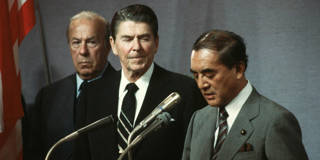Back in the 1980s, Japan was portrayed as the greatest economic threat to the United States, and allegations of intellectual property theft were only part of Americans' vilification. Thirty years later, Americans have made China the villain, when, just like three decades ago, they should be looking squarely in the mirror.
NEW HAVEN – “When governments permit counterfeiting or copying of American products, it is stealing our future, and it is no longer free trade.” So said US President Ronald Reagan, commenting on Japan after the Plaza Accord was concluded in September 1985. Today resembles, in many respects, a remake of this 1980s movie, but with a reality-television star replacing a Hollywood film star in the presidential leading role – and with a new villain in place of Japan.
Back in the 1980s, Japan was portrayed as America’s greatest economic threat – not only because of allegations of intellectual property theft, but also because of concerns about currency manipulation, state-sponsored industrial policy, a hollowing out of US manufacturing, and an outsize bilateral trade deficit. In its standoff with the US, Japan ultimately blinked, but it paid a steep price for doing so – nearly three “lost” decades of economic stagnation and deflation. Today, the same plot features China.
Notwithstanding both countries’ objectionable mercantilism, Japan and China had something else in common: They became victims of America’s unfortunate habit of making others the scapegoat for its own economic problems. Like Japan bashing in the 1980s, China bashing today is an outgrowth of America’s increasingly insidious macroeconomic imbalances. In both cases, a dramatic shortfall in US domestic saving spawned large current-account and trade deficits, setting the stage for battles, 30 years apart, with Asia’s two economic giants.

NEW HAVEN – “When governments permit counterfeiting or copying of American products, it is stealing our future, and it is no longer free trade.” So said US President Ronald Reagan, commenting on Japan after the Plaza Accord was concluded in September 1985. Today resembles, in many respects, a remake of this 1980s movie, but with a reality-television star replacing a Hollywood film star in the presidential leading role – and with a new villain in place of Japan.
Back in the 1980s, Japan was portrayed as America’s greatest economic threat – not only because of allegations of intellectual property theft, but also because of concerns about currency manipulation, state-sponsored industrial policy, a hollowing out of US manufacturing, and an outsize bilateral trade deficit. In its standoff with the US, Japan ultimately blinked, but it paid a steep price for doing so – nearly three “lost” decades of economic stagnation and deflation. Today, the same plot features China.
Notwithstanding both countries’ objectionable mercantilism, Japan and China had something else in common: They became victims of America’s unfortunate habit of making others the scapegoat for its own economic problems. Like Japan bashing in the 1980s, China bashing today is an outgrowth of America’s increasingly insidious macroeconomic imbalances. In both cases, a dramatic shortfall in US domestic saving spawned large current-account and trade deficits, setting the stage for battles, 30 years apart, with Asia’s two economic giants.